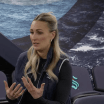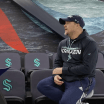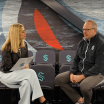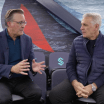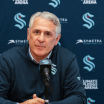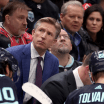In hockey, every front office can be different, in that general managers and assistant general managers have different strengths that they bring to the team. How would you describe your role and specific contributions within the Kraken's front office?
(Smiles) I'm happy to do whatever is asked. Ron (Francis) describes me as a “jack of all trades”. Given my legal and playing background and experience, this allows me to be involved in all areas of hockey operations. I've been truly blessed to be around the great game of hockey my whole life (so given that breadth of experience), I wear numerous hats.
Are there certain facets of your role that you are really passionate about?
My passions lie in negotiating player contracts, the collective bargaining agreement (CBA); cap management, trades, and player evaluation.
Not everyone probably understands how big the CBA is, how intricate it is. Do you have a process to stay on top of it and how do you navigate understanding any change or nuances within it?
I'm “old school” and a traditionalist. I used to keep the CBA literally on my bedside table because one never knew when the GM would be seeking an answer to a question. The CBA is a voluminous document with numerous exhibits and complexities, but I have a considerable familiarity with it most assuredly. And I have inserted different colored tabs and notes throughout, similarly as I did in law school and studying for the bar exam. This allows me to access information quickly to review and confirm.
The CBA is something that I review periodically. Particularly, I will review certain sections at certain times of the year to be fully prepared, for example, salary arbitration.
And now I access my CBA in PDF format on my iPad, so that makes it much easier to access information. Obviously, this “old school” person is a bit more hip now --- but then again, probably not (laughs). Instead of logging this massive document in my computer bag, it (the CBA) is easily accessible digitally for convenience and expedience.
If there's ever anything up for interpretation, do you have resources if you're trying to seek specifics on something that is stated?
If something is stated in the CBA, I either know it through past practice and experience, or I can reach out to the League for clarification or confirmation.
We're coming up on the trade deadline (March 8). Broadly, do you have a sense if this will be a busier deadline across the League? Do you have a feel for what you expect to happen activity-wise?
The short answer to your question, Alison, is no. One never knows from year to year. Situations constantly change with teams leading into the Trade Deadline so the positions to buy or sell are simply snapshots in time. On February 1, for example, a team may think 'we're going to be buyers,' and then suddenly, days or weeks later, they've gone 1-7-0, and they now think 'we're sellers'. Injuries also provide other challenges as well.
General Managers use various strategies to participate in the marketplace. Some may be more aggressive and try to “get ahead of the pact” thereby addressing their respective needs immediately. The attempts here are to avoid paying a higher or exorbitant price closer to the deadline.
Others, however, choose a more measured and patient approach. The wait-and-see option - to call someone's bluff. Perhaps a team says, 'we're looking to buy,', and the seller seeks a first-round (draft pick) in return.' So then (the buying team) may see if they can get the seller at a second (round pick). The marketplace fluctuates. It is fluid.
Right now...much chatter is taking place amongst the GMs. That's consistent. Ron is always on his phone seeking the pulse around the League. Where this ends up? Stay tuned, hockey fans.
Can you walk us through in a broad sense, how exactly does a trade go down? How does that all happen?
Procedurally, GMs reach out to their respective colleagues about potential moves – who is available, what the needs of the club are, etc. It usually takes time. However, I recall a trade years ago where the trade was consummated after only one conversation - deal done. That rarely happens, but it does happen. Normally, there is some posturing going back and forth between the parties. Everybody is trying to get the “better of the deal”. But at some point, instead of just digging in your heels and saying, 'I'm going to remain steadfast in my position,' now we're going to come together, meet in the middle and reach a deal. It could take days, weeks, months, if at all. The objective is to get a deal done.
Once completed, the general manager will inform a person in their hockey operations department, commonly the assistant general manager, who will contact the League and notify it that a trade has been consummated outlining the details of the proposed transaction. Then the League will review internally with background checks on roster availability, cap compliance, etc.
Thereafter, the League conducts a trade conference call with the teams involved. And on such call, it goes through a checklist and when the call ends, the deal is officially completed.
Now, each respective team will notify their players involved in the trade as a professional courtesy - that's what every team wishes to do. And once completed, clubs exchange player contact information. Immigration issues may come into play, (which is always interesting and can be challenging, especially around the trade deadline). A media announcement follows shortly thereafter.
You mentioned that human side of communicating with the players. You talk with players, you have relationships with them. Can you share how you navigate building relationships with players but then this is also a business and sometimes you have to tell that player that they're no longer part of the team?
It's tough. No question. You build relationships with players and their respective families. They are NOT simply “assets.” They are human beings. They have feelings. You witness young players maturing into young men. You observe their challenges, defeats, triumphs, successes. We share in the joy of the births of their children and marriages.
But having said all that, both the clubs and the players recognize and accept that the NHL is still a business. We represent the Seattle Kraken Hockey Club, and we have an obligation and duty to do what's best for the organization, both short-term and long-term. And the players have a job to perform. Notwithstanding building such relationships, these conversations can be and are quite difficult at times. The players appreciate that you have invested the time to get to know them, that you care, and there is mutual respect.
You mentioned that checklist of making sure you can execute a trade. From a salary cap perspective, what are the considerations that you have in mind going into a trade deadline and maybe post-deadline? Are there different implications there?
So, there will be discussions with Ron about the short term – for example, what is our current position: can we acquire a certain player, do we have the cap space? And then discussions about the long term -- what is the impact on the following season or subsequent seasons thereafter? Whose contracts are expiring the upcoming or following summers? Where's that going to fit in? Is the cap increasing? What are the chances of that? Do we have to make other adjustments? All these different variables, and others, factor into the decision-making process. It is not simply a snapshot in time. We also have to consider the impact of moving forward, most assuredly.
There are some post-trade deadline rules that change regarding roster size, the number of call-ups, for example. What are some new considerations that the front office has to have in mind when you’re managing the roster post-deadline?
Post deadline, the Club's Active Roster may be increased to any number of Players the Club determines with the caveat that the Club must be CAP compliant. Additionally, Clubs may exercise four (4) regular Recalls from the minor leagues.
One thing Clubs are still able to do is make trades. This impacts and affects more the American Hockey League and its trade deadline a week following the NHL’s.
And there can also be moves between an NHL club and their AHL affiliate at the deadline that have to do with keeping players eligible for AHL playoffs, as well. How does that work?
To be eligible to participate in the AHL post-season, a player must be loaned to the minors prior to the NHL trade deadline. Subsequently, the Clubs will make recalls as needed but these players will be able to be loaned back to the American Hockey League at the conclusion of the NHL Regular Season and or Playoffs.
There was one other tool that this team has had to use a little bit more this year, unfortunately than last and that’s navigating injuries. A player can be injured, but there can be a status attached to their name that doesn’t necessarily directly correlate to their physical health, like retroactive status on long-term injured reserve (LTIR), or injured reserve (IR). What can you share about what those differences mean and why those tools might be used?
By the way, I'm sure you were aware that yesterday (02/15 vs. BOS) was our fourth game in a row and only our fourth game of the entire season where we've had the entire team roster healthy with no one on IR or LTIR. Injured reserve means that a player is unable to participate in NHL game action for a minimum of seven days. Long-term injured reserve occurs when a player is out for a longer duration, that is he is unfit to play for at least a time period of 10 NHL regular season games, and 24 calendar days.
In order to place someone on LTIR retroactively, a Club has previously placed a player on IR originally and the status of the injury has changed. If the minimum of 10 NHL regular season games and 24 calendar days to be unfit is determined before the player is fit to play, then a Club may invoke LTI.
Once the player is healthy to return, the Club must make certain that a Roster spot exists for such player. The maximum number of players a Club may have on a regular season roster is 23 until the Trade Deadline, of course.
Where's your favorite place to watch a game from at Climate Pledge Arena?
I do enjoy watching the games down by the ice crew at CPA for sure. It offers a unique perspective to observe what the players are “looking at”, and picking up different cues, the intensity, players’ reactions, the compete level, and the speed at ice level. So that is why I enjoy viewing games at that location. And it gives Ron a break (jokingly).
You have an intense and very important job. What is your stress relief? How do you maintain balance?
I welcome and embrace this job and I know what it entails. And to me, I think it's more about dealing with this energy. That is – how it is channeled and directed. Are there days with an excessive number of matters to attend to? Absolutely. It is crunch time and there are deadlines/filings to be met (there could be consequences). I understand that. But what is one’s reaction and perspective? It's channeling that energy. I love what I'm doing. I'm extremely blessed to be around and working alongside these wonderful folks in this great Seattle Kraken organization. For me, it's a luxury to come to work every day.
And when I am not at KCI, CPA, an arena, or on a plane, my passion is trail running. Give me the mountains and give me the heat. The hotter the better. Tranquility at its pinnacle.
Anyone who’s been around you knows you take your work seriously but you also always bring energy and positivity. How would you describe that element that you bring to the Seattle Kraken?
Oh, comedic relief. That's important, (laughs). I know days can be tough and challenging. But I want people to have fun and enjoy themselves. Enjoy life. Breath in the bod. Life is short.......and so is Ricky O.
This transcript was lightly edited for brevity and clarity



